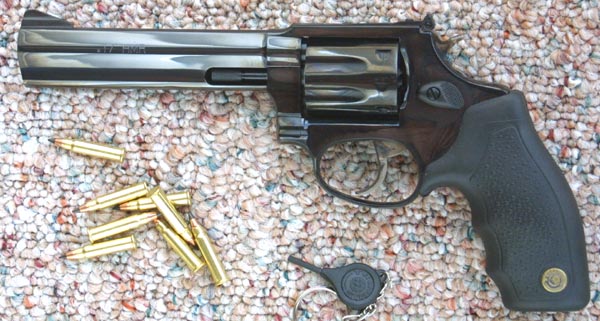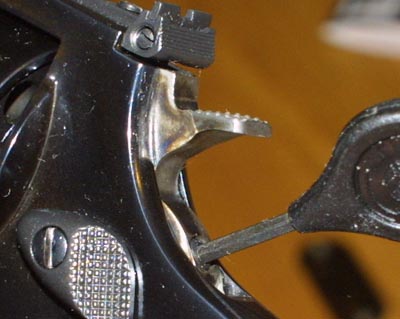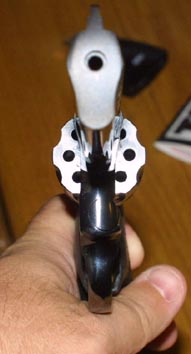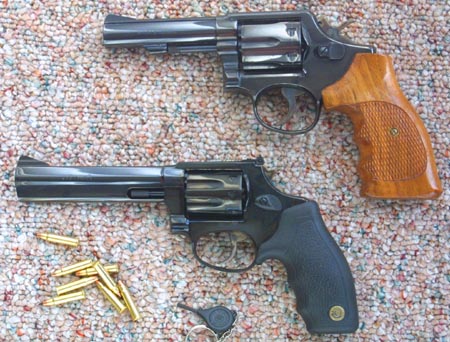 Taurus 17
Taurus 17
| Length overall | Barrel Length | Weight | Caliber | Action Type | Capacity |
| 9.75 inches |
5 Inches |
26.5 ounces |
17 hmr | revolver | 8 |
This is a nice sized, comfortably shooting, handy revolver for the sportsman, hiker, camper, or recreational shooter. Though the cost of the rounds (about 20 cents each, as of this writing) does not necessarily make this a plinker, the dynamics of the gun would certainly make it a good choice. This is a fancy way of saying that the gun is fun, and easy to shoot. This would make an excellent kit gun, and unlike the S&W kit gun, it is actually affordable enough that you would not be afraid to consign it to the type of hard life and casual concern to which, by definition, a kit gun is subject. As of late summer of 2005, I paid about $250 for this gun, brand new. This was a good price, but by no means a steal, and the average shooter shouldn't have too much trouble finding the Taurus 17 at a similar price.
The fit and finish of the gun are great. The metal is smooth, with a mirror finish. The deep blue is uniform, and almost looks black. The ergonomically designed grips take the form of a reverse wedge, with finger cut outs, and are of pebble grained black rubber, with a Taurus logo medallion near the bottom. The barrel is completely underlugged, with a sort of a triangular cross section, like that on the Raging Bull. The front of the barrel, along with the underlug, is radiused, like that of the Colt Detective Special, or the old High Standard Sentinel MkIV. Though this is probably a bit of a vanity feature, I suspect that the radiused barrel is responsible for the sale of many a Detective Special. The crown of the barrel is slightly recessed, making it an unlikely recipient of damage from rough handling. All and all, the gun is very handsome appearing. Nickel, and stainless versions are also available.
 This gun features the Taurus safety system, by which
the hammer can be locked into position by a small hex key. The system may
be safely bypassed by simply never locking the hammer, though for a household
with children, the hammer might be left locked. This isn't really a lock,
in the traditional sense, since hex keys are universal, and the system
could probably be unlocked with a small screwdriver, or anything else that
could be made to fit. It is more like an elaborate, somewhat intrusive
safety. I have no problem with the system, and do not object to it's inclusion
on the gun; but will certainly never use it myself. I suspect that it's
design owes more to lawyers than to firearms experts. The system probably
adds less than a dollar to the cost of producing these guns, and does not
normally interfere with operation. Just don't forget where that hex key is,
if you ever decide to lock the gun.
This gun features the Taurus safety system, by which
the hammer can be locked into position by a small hex key. The system may
be safely bypassed by simply never locking the hammer, though for a household
with children, the hammer might be left locked. This isn't really a lock,
in the traditional sense, since hex keys are universal, and the system
could probably be unlocked with a small screwdriver, or anything else that
could be made to fit. It is more like an elaborate, somewhat intrusive
safety. I have no problem with the system, and do not object to it's inclusion
on the gun; but will certainly never use it myself. I suspect that it's
design owes more to lawyers than to firearms experts. The system probably
adds less than a dollar to the cost of producing these guns, and does not
normally interfere with operation. Just don't forget where that hex key is,
if you ever decide to lock the gun.The adjustable sights are relatively large, for a gun of this class, and give a great sight picture. The front is a ramp, while the rear is a conventional unit adjustable for windage, and elevation. There are no dots, dashes, outlines, inserts, or other distractions on these sights, which is quite to my liking. The sights are easy enough to adjust, and are quite identical to the standard S&W sights, as far as I can tell.
The low point of the gun is it's trigger. The double action trigger pull is long, and heavy. The single action pull is quite good, though it too, was a bit heavier than I expected, particularly from such a small gun. In neither case is this a great trigger, lacking the smooth consistency of my beloved Smiths. Even so, this is a brand new gun, and the trigger may work itself smooth in time. The hammer spring is very stiff, and it requires quite a pull of the thumb to be drawn back for single action shooting. As with the trigger, the hammer spring will probably loosen up over time. This may be a result of some problems that Taurus revolvers of a decade or two were having, with light strikes on primers. The company seems to have switched to a heavier spring to prevent any possible recurrence of this issue. Like most modern revolver designs, the Taurus uses a transfer bar between the hammer, and the frame mounted firing pin. The transfer bar does not slide up to contact the firing pin unless the trigger is pulled, preventing a sharp rap on the hammer from accidentally firing the gun.
 Shooting the Taurus, trigger notwithstanding, is
a pleasure. The gun feels good in the hand, recoil is not difficult, and
the sights are easy to use. The 17 is inherently a very accurate round;
but I was only able to group into a couple of inches at the range. Much of
this was probably due to the trigger, though in all fairness, I can only
do slightly better with my 22 Dan Wesson. I will have to put a number
of boxes of ammunition through this gun, before making my final judgment
of the trigger. Varmint hunters love this round, fired from a heavy barreled
rifle. The 17 shoots much flatter than what I am used to from a pistol, and
puts what seem to my eyes, to be remarkably small holes in the targets. There
is also a remarkably small hole at the muzzle, which makes the gun seem
not very intimidating, until you consider that the bullets exiting this
minuscule opening are sizzling along at over 2500fps.
Shooting the Taurus, trigger notwithstanding, is
a pleasure. The gun feels good in the hand, recoil is not difficult, and
the sights are easy to use. The 17 is inherently a very accurate round;
but I was only able to group into a couple of inches at the range. Much of
this was probably due to the trigger, though in all fairness, I can only
do slightly better with my 22 Dan Wesson. I will have to put a number
of boxes of ammunition through this gun, before making my final judgment
of the trigger. Varmint hunters love this round, fired from a heavy barreled
rifle. The 17 shoots much flatter than what I am used to from a pistol, and
puts what seem to my eyes, to be remarkably small holes in the targets. There
is also a remarkably small hole at the muzzle, which makes the gun seem
not very intimidating, until you consider that the bullets exiting this
minuscule opening are sizzling along at over 2500fps.The pistol itself is essentially a version of the excellent model 94, in 22 magnum, which is necked down to take the .17 cartridge. The model 94 is itself, a small bore version of the popular medium frame 85 series. These guns are S&W J frame knock offs, though they have a certain advantage over the cheaply made imitation Smiths made by some other companies. In order to appreciate the reason for this, a bit of history is required. I am quite familiar with the Taurus model 85, and had one for a number of years. The gun was a good performer, and a real bargain (still true on both counts).
In 1965, S&W was bought by the huge South American conglomerate, Bangor Punta. Bangor Punta had large manufacturing facilities down in Brazil, including those or Taurus (which it had bought in 1970), as well as those it had purchased as a part of it's S&W acquisition. Taurus had been around since the forties, as a machine shop, and gun manufacturer. After being purchased by Bangor Punta, the factory began to manufacture, what were in essence S&W handguns in Brazil, for distribution in South America. Though the company had it's own designs for revolvers, there had been quite a bit of sharing while the two firearms manufacturers were both under the parentage of Bangor Punta, and Taurus was greatly influenced by S&W. Taurus does not necessarily like to be thought of as making S&W clones. Even so, I notice that the cylinder release on the Taurus was reshaped at about the same time as the Smith, and now has the same profile. I also notice that the Taurus revolver comes packed in a blue cardboard box, with white writing, just like generations of the Smith. Smith and Wesson now packs their revolvers in blue plastic boxes. I am waiting to see how long it will take Taurus to follow suit.
Bangor Punta owned a number of companies at that time, including several boat building companies. In many ways the history of S&W, and of Taurus, and their relationships with Bangor Punta, are reminiscent of that between AMF and Harley Davidson. In 1977, Taurus bought itself back from Bangor Punta, in a move similar to that made by Harley Davidson. S&W was also bought from Bangor Punta, which essentially divested itself of all other interests, and dissolved a few years
 latter. Incidentally, Bangor Punta started out as a timber company.
Talk about politically incorrect, here is a company started to cut down
the rain forests, which then moved into firearms production. My admiration
is unbounded.
latter. Incidentally, Bangor Punta started out as a timber company.
Talk about politically incorrect, here is a company started to cut down
the rain forests, which then moved into firearms production. My admiration
is unbounded.There had been some early rumors of rather poor or uneven quality in the Brazilian guns, similar to those circulated about Spanish made firearms. There was also the aforementioned difficulty about light primer strikes. Taurus wished to enter the U.S. market in a big way; but with it's tarnished reputation, it needed to do something in order to attract buyers. It could have, as had the Spanish companies, lowered prices, making itself a bottom of the line gun company, and having to reduce quality in order to be profitable at a lower price. Instead, at the 1984 SHOT Show, Taurus announced that from that point forward, all Taurus handguns would carry a Lifetime Repair Policy. Such a thing was unheard of, even from first line companies like S&W, and Colt. It did much to instill buyer confidence, and to restore the credibility of the company.
In 1989, Taurus bought the Brazilian production facilities of Beretta. This factory had been built as part of a contract to supply hand guns to the Brazilian government. Part of the deal was that manufacture must take place in Brazil. For six years, from 1974, the Sao Paulo factory of Beretta produced M-92 automatics, until the contract ran out. When Taurus took the factory over, it began producing what were essentially genuine Beretta handguns, made in a Beretta factory, by Beretta trained workers. So now Taurus was able to produce a line of automatics, as well as it's traditional line of revolvers.
With Beretta line, as well as the S&W line, Taurus could easily have rested on it's laurels, and continued producing these products, as a sort of a clone maker. Numerous computer companies, and not a few firearms manufacturers are doing quite well by following this plan; but Taurus didn't sit still. The Taurus line of semi auto pistols now differs significantly from the mechanics of the Beretta design. In particular, the Taurus has it's safety mounted on the frame, rather than on the slide. This allows cocked and locked carry, something which can not be done with the Beretta. The company has also redesigned the internal lockwork, slightly, on it's revolver line, so that it now significantly differs from that of the Smith. Some shooters lament this, suspecting that cost may have been a factor in the redesign. Others applaud the changes, considering them to be, as is clamed by Taurus, improvements and evolutions in the original Smith design. I will note that the new guns no longer suffer from the intermittent problems of light primer strike, that they all use coil springs, along the lines of the Dan Wesson, and that they have a rather stiff trigger pull out of the box. You will want to make up your own mind about this. One thing is certain, however. Taurus is not a manufacturer of either S&W, or Beretta clones.